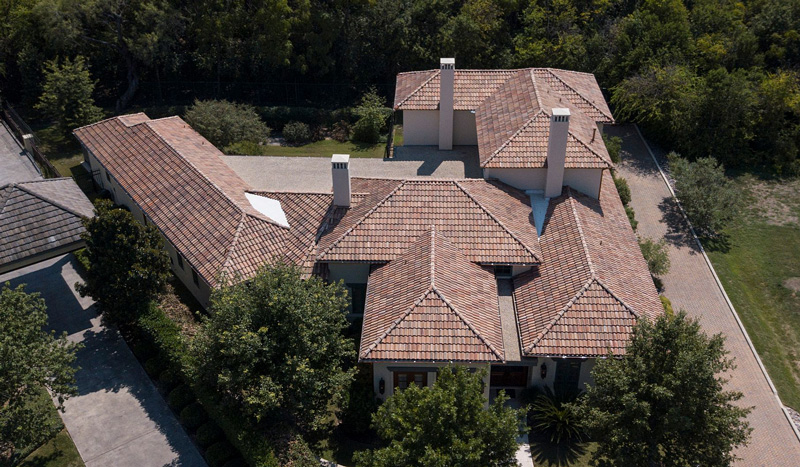
A roof not only defines the aesthetic appeal of the building but also plays a significant role in its structural integrity and functionality. While there are numerous roof types to consider, this post will be looking at some of the differences between Gable and Hip roofs, as they remain two of the most popular choices in modern architecture. We’ll look at their structural differences, functional advantages, and aesthetic considerations.
Historical Context and Popularity
Gable Roofs: Originating in ancient Greece, the Gable roof has been a staple in Western architecture for centuries. Its simple design and effective water drainage made it a popular choice for various building types, from temples to residential homes.
Hip Roofs: With roots in both Asian and Mediterranean architecture, Hip roofs are known for their stability and aesthetic appeal. They have been widely used in regions prone to high winds and hurricanes, thanks to their aerodynamic design.
Current Trends and Statistics
In recent years, both Gable and Hip roofs have seen a resurgence in popularity, albeit for different reasons.
- Gable Roofs: Often favored for their lower construction costs and ease of ventilation, Gable roofs are commonly seen in suburban housing developments and commercial structures.
- Hip Roofs: On the other hand, Hip roofs are increasingly being chosen for their aesthetic versatility and superior weather resistance, making them a preferred option for high-end residential and commercial projects.
Understanding the historical context, you will be better able to appreciate the unique qualities that each roof type brings to the table.
Structural Differences
Framing and Components
Gable Roofs: The framing for a Gable roof primarily consists of rafters, ridge boards, and sometimes trusses. The design is relatively straightforward, with two sloping sides meeting at a central ridge. This simplicity often translates to quicker construction times and lower costs.
Hip Roofs: Hip roofs are more complex in their framing, involving hip rafters, common rafters, and jack rafters. The four-sided design requires more intricate planning and execution, which can extend construction timelines and increase costs.
Slope and Pitch
Gable Roofs: Generally, Gable roofs have a wider range of acceptable pitches, from shallow to steep. The pitch can significantly affect drainage capabilities, snow load distribution, and even aesthetic appeal.
Hip Roofs: Hip roofs usually feature a more moderate pitch, optimized for wind resistance. The gentler slopes make them less ideal for snow-prone areas but excellent for high-wind regions.
Ventilation and Insulation
Gable Roofs: The simpler design allows for easier incorporation of ventilation systems, such as gable vents or ridge vents. This makes it easier to manage moisture and temperature within the attic space.
Hip Roofs: While not impossible, integrating effective ventilation systems into a Hip roof can be more challenging due to its complex structure. However, the design naturally offers better insulation, reducing energy costs in the long run.
Functional and Aesthetic Considerations
Weather Resistance
Gable Roofs: While effective in shedding water, Gable roofs can be susceptible to wind uplift, especially if not properly braced. This makes them less ideal for hurricane-prone areas.
Hip Roofs: The aerodynamic design of Hip roofs offers superior wind resistance, making them an excellent choice for regions that experience high winds or hurricanes.
Architectural Styles
Gable Roofs: These roofs are versatile and can complement various architectural styles, including Colonial, Tudor, and Modern.
Hip Roofs: Hip roofs are often associated with more elaborate architectural styles like French Provincial, Italian Renaissance, and Craftsman.
Cost and ROI
Gable Roofs: Generally cheaper to build due to their simpler design, Gable roofs offer a good return on investment, especially for budget-conscious projects.
Hip Roofs: While the initial cost can be higher, the long-term benefits of better weather resistance and lower energy costs can offer a more favorable ROI in the long run.
Overall Pros and Cons
To make an informed decision about which roof type is best suited for your project, it’s crucial to weigh the pros and cons of each.
Gable Roofs Pros
- Lower Initial Cost: The simpler design and framing requirements often result in a lower initial construction cost.
- Good for Snow and Rain: The steep pitch is effective for quick water drainage and snow shedding, making it suitable for regions with heavy precipitation.
- Easier to Ventilate: The design allows for easier incorporation of ventilation systems, which can be beneficial in managing moisture and temperature within the attic space.
- Versatility: Gable roofs can complement a wide range of architectural styles, making them a versatile choice.
Gable Roof Cons
- Susceptible to Wind Uplift: If not properly braced, the design can be vulnerable to wind uplift, making it less ideal for hurricane-prone areas.
- Higher Maintenance Costs: While the initial costs may be lower, potential issues like wind damage could result in higher long-term maintenance costs.
Hip Roofs Pros
- Excellent Wind Resistance: The aerodynamic design offers superior resistance to wind, making it an excellent choice for regions prone to hurricanes or high winds.
- Better Natural Insulation: The complex structure can offer better natural insulation, which could result in lower energy costs in the long run.
- Aesthetic Appeal: Hip roofs often complement more elaborate architectural styles, adding to the overall aesthetic value of the building.
Hip Roof Cons
- Higher Initial Cost: The complex framing and construction requirements often result in a higher initial cost.
- More Challenging to Ventilate: The intricate design can make it more challenging to incorporate effective ventilation systems.
- Less Ideal for Heavy Snow: The gentler slopes may not shed snow as effectively as steeper Gable roofs, making them less ideal for snow-prone areas.
Hopefully this deep dive into the world of Gable and Hip roofs is enlightening and useful. Whether you’re an architect, a builder, or simply a roofing enthusiast, the choice between these two popular roof types is a significant one, filled with considerations that go well beyond the surface.





